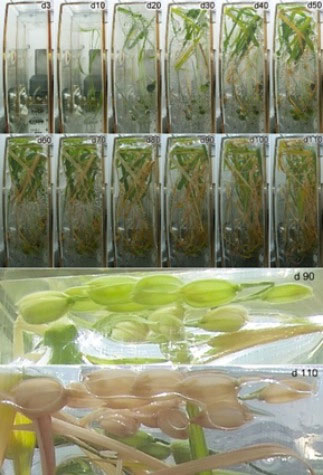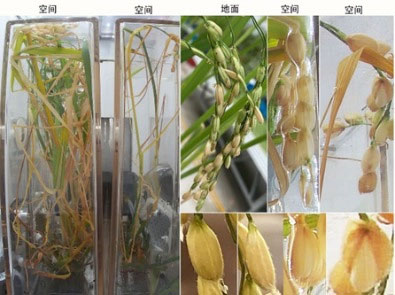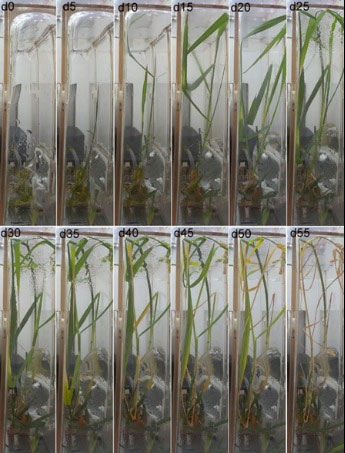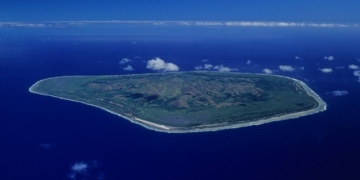The rice plants were grown from seeds and then bloomed in “space,” after which all of them were brought back to Earth.
On December 4, 2022, the return module of the Shenzhou 14 manned spacecraft successfully landed at the Dongfeng landing site in China.
However, this return was not just about humans; it also included important experimental samples from numerous significant experiments conducted in space. After landing on Earth, these samples were quickly transported to the Space Application Research and Engineering Institute of the Chinese Academy of Sciences. Once it was confirmed that the samples returned in good condition, they were smoothly handed over to the relevant scientists.
Notably, there were three cold storage bags containing biological samples of rice and Arabidopsis thaliana from cultivation experiments. Arabidopsis thaliana is a small flowering plant belonging to the mustard family.

The entire life cycle of rice grown in space.
Both rice and Arabidopsis underwent 120 days of planting and growth in space, completing the entire development process from seed to seed. This marks the first time in the world that humans have obtained rice seeds in orbit.
Currently, the rice seeds and Arabidopsis seeds grown in space will be taken back to the laboratory of the Chinese Academy of Sciences for continued cultivation. Scientists will conduct analyses related to molecular biology, cytology, and metabolism on the returned samples. Through this research process, they hope to analyze the rules and foundational principles for assessing the impact of microgravity environments on crops. This could lead to the development of crops that can adapt to space environments. This research will provide a theoretical basis for developing and utilizing resources from microgravity environments in space.
Conducting Rice Cultivation Experiments in Orbit for 120 Days
Rice is a staple food for humans, feeding nearly half of the world’s population, and it is also a primary candidate among staple crops to support life in future manned deep space exploration activities.
If humans wish to exist long-term in space, they must ensure that plants can complete their growth processes and produce new generations in space, specifically by successfully reproducing seeds.
Previously, cultivation from seeds of Arabidopsis, rapeseed, peas, and wheat had been conducted, but rice had not completed its entire life cycle in space. This was partly because space science projects have typically been undertaken by European and American scientific organizations.
Scientist Zheng Huaiqun is examining the plant samples brought back from orbit.
However, Chinese scientists, led by researcher Zheng Huaiqun from the Molecular Biotechnology Center of the Chinese Academy of Sciences, decided to carry out the first-ever rice cultivation experiment in space.
Simultaneously, since flowering is a prerequisite for seed formation, they used Arabidopsis thaliana as a model plant to systematically study the effects of microgravity on flowering.
From the time nutrient solution was injected on July 29, 2022, until the experiment concluded on November 25, 2022, the project was conducted in orbit for a total of 120 days. The experiments completed the entire life cycle of Arabidopsis as well as witnessed the germination of rice seeds, the growth of seedlings, the flowering process, and seed setting.
During this period, astronauts conducted three sampling sessions in orbit, including sampling rice at the germination stage on September 21, sampling Arabidopsis thaliana at the flowering stage on October 12, and sampling at the maturity stage of both rice and Arabidopsis on November 25.
After collection, samples at the flowering or germination stages were stored in a low-temperature storage unit at -80°C, while samples at the mature seed stage were stored at 4°C.
Feasibility of Rice Cultivation in a Confined and Closed Environment
According to the initial findings of the research team, microgravity has affected various agronomic characteristics of rice, including plant height, number of tillers, growth rate, water regulation ability, light response, flowering time, seed development, and seed setting rate.
Specifically, rice plants developed “looser” in space, primarily due to the angle between the stem and leaves becoming larger. Notably, the upward spiral motion of rice leaf development—controlled by biological clocks—became more pronounced when grown in space.

Comparison of the original rice plant and the regenerated plant after being cut.
Additionally, the flowering time of rice was slightly earlier compared to when grown on Earth, but the overall flowering duration was extended by 10 days, and most of the husks surrounding the seeds did not close.
Both flowering and seed setting times are important agronomic characteristics of rice. They play a crucial role in ensuring sufficient reproductive development of the plant and obtaining high-yield, high-quality seeds. This process is regulated by gene expression, and the returned samples will be used for further analysis.

Regeneration images of rice in space, with numbers indicating days after cutting.
Moreover, rice shoots can regenerate about 20 days after being cut. This indicates that regenerating rice plants in a closed environment with limited space is feasible, while also providing new ideas and experimental evidence for efficient space crop production.
According to scientists, this technology could significantly increase rice yield per unit volume, and it is also the first rice regeneration technology tested in space globally.


















































